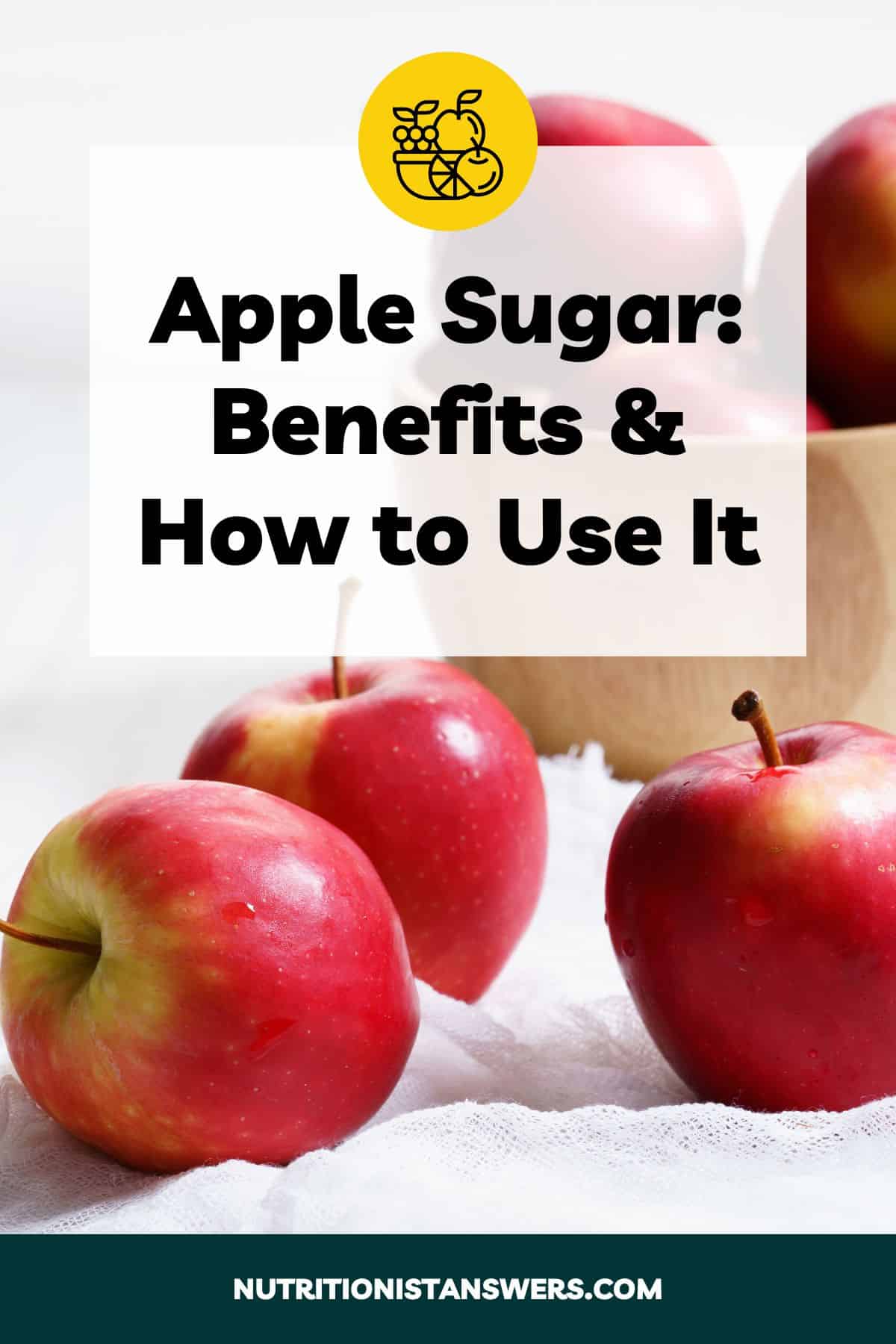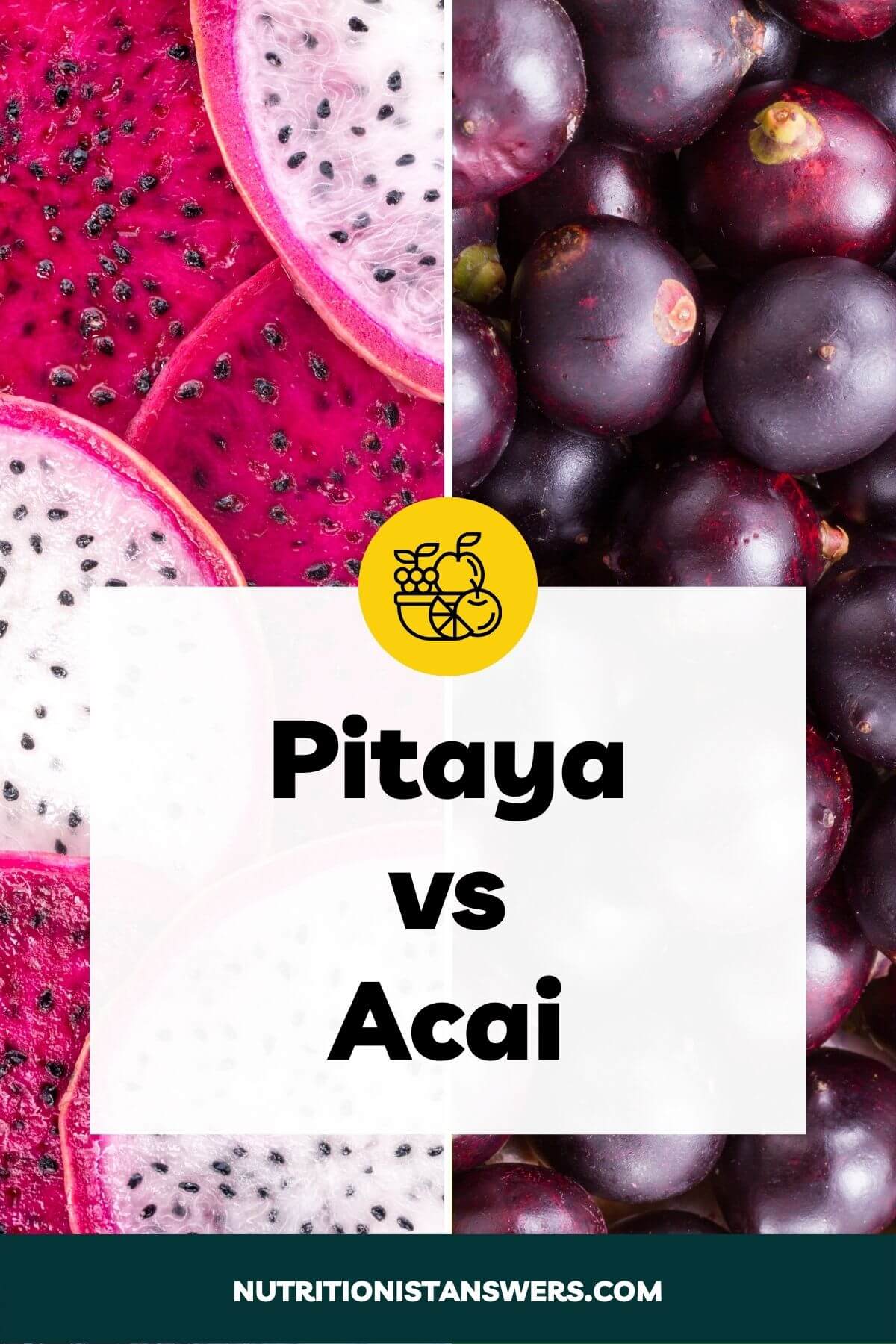Acai and blueberries are both popular fruits that are often used in smoothies, juices, and other delicious snacks. But what exactly is the difference between these two berries?
How do they compare in flavor and nutrition? And can they be used in the same ways?
This article will compare acai and blueberries so you can choose the best option for your culinary and nutrition needs.
Please note that this article contains affiliate links. If you click one of these links and make a purchase, we may earn a commission. As an Amazon Associate, we earn from qualifying purchases.
What is acai?
Acai (“ah-sigh-ee”) berries are fruits produced by Acai palm trees that grow in the Amazon rainforest of South America (1).
These dark purple fruits are small and round with a single large seed in the middle. Because of this, they are actually classified as drupes (or stone fruits) rather than berries.
Many people have described its flavor as a cross between blackberries and dark chocolate — in other words, bitter and earthy with a hint of sweet and sour.
Acai berries have long been a diet staple for indigenous people living in the Amazon region of South America, including Brazil (1).
One of the most popular ways to consume acai is açaí na tigela, which means “acai in the bowl” in Portuguese.
Traditionally, this popular dish is made from frozen acai pulp that has been blended with guarana syrup, poured into a bowl, and topped with other fruits, nuts, and seeds.
In the United States, a version of this dish called an “acai bowl” has served as a trendy breakfast or snack option since the early 2000’s.
Acai nutrition
Acai berries, in comparison to other fruits, have a unique nutrient profile — they are low in carbohydrates, high in fat, and even provide a small amount of protein.
A 3.5-ounce (100-gram) serving of frozen acai puree provides the following nutrients (2, 3, 4, 5):
- Calories: 65
- Protein: 2 grams
- Fat: 5 grams
- Carbohydrates: 5 grams
- Fiber: 4 grams
- Sugars: <0.5 grams
- Calcium: 40 mg (3% DV)
- Iron: 1.1 mg (6% DV)
- Potassium: 105 mg (2% DV)
- Vitamin C: 10 mg (11% DV)
- Vitamin A: 1000 IU (20% DV)
Copper, magnesium, manganese, and zinc are also found in freeze-dried acai powder, but it’s unclear how much is found in frozen acai pulp (6).
What are blueberries?
Blueberries are small, dark blue fruits that grow on flowering shrubs belonging to the Vaccinium family, which also includes cranberries and bilberries (7).
They are native to North America, where they are one of the most commonly consumed berries, but are also grown in Europe, Asia, and South America (7, 8).
The two main varieties are highbush (cultivated) blueberries, which are produced throughout the United States, and lowbush (wild) blueberries — mainly grown in the northeastern states (8).
Unless labeled otherwise, blueberries found at the grocery store are the highbush variety. They’re about ½ inch in diameter and have sweet, juicy flesh.
Wild blueberries, on the other hand, are smaller (¼ inch diameter), and have a more intense flavor — mostly sweet with a hint of tanginess.
Grocery stores carry fresh blueberries year-round, but they are often easier to find from April to September when they’re in season. Frozen, dried, and canned blueberries are also available.
These delicious berries can be blended into smoothies, tossed into salads, or incorporated into baked goods like muffins, pancakes, and pies.
Blueberry nutrition
A 3.5-ounce (100-gram) serving of fresh blueberries provides the following nutrients (9):
- Calories: 57
- Protein: 0.7 grams
- Fat: 0.3 grams
- Carbohydrates: 15 grams
- Fiber: 2 grams
- Sugars: 10 grams
- Calcium: 6 mg (<1% DV)
- Iron: 0.3 mg (2% DV)
- Magnesium: 6 mg (1% DV)
- Potassium: 77 mg (2% DV)
- Copper: 0.06 mg (7% DV)
- Manganese: 0.3 mg (13% DV)
- Vitamin C: 10 mg (11% DV)
- Vitamin A: 54 IU (1% DV)
- Vitamin K: 19 mcg (16% DV)
Acai vs blueberry
Acai and blueberries have a lot in common, but there are some noticeable differences in their flavor profile and nutrition content.
Flavor comparison
Acai is known for its bitter, tangy, and slightly sweet flavor, often described as a cross between blackberries and dark chocolate.
Blueberries, on the other hand, are sweet, juicy, and somewhat tart depending on how ripe they are.
Acai pairs well with tropical fruits and coconut, while blueberries are often paired with lemon, warm spices, nuts, and dairy products.
If you’re in the mood for a fruit that’s sweet and mild, blueberries are the clear winner, but if you want a more complex flavor, then acai might be the better choice.
However, you may not have to choose between the two! Both fruits complement each other well in smoothies, oatmeal bowls, and even baked goods.
Nutrition comparison
Here’s a side-by-side comparison of the calorie and macronutrient content of pitaya and acai, based on a 3.5-ounce (100-gram) serving size (2, 3, 4, 9, 10):
| Nutrient | Acai (frozen pulp) (100g) | Blueberries (fresh) (100g) |
| Calories | 65 | 57 |
| Protein | 2 grams | 0.7 grams |
| Fat | 5 grams | 0.3 grams |
| Carbohydrates | 5 grams | 15 grams |
| Fiber | 4 grams | 2 grams |
| Sugars | <0.5 grams | 10 grams |
Calories
Like most fruits, acai and blueberries are relatively low in calories. A 3.5-ounce (100-gram) serving of acai provides 65 calories, while an equal portion of blueberries offers 57 calories.
Protein
Acai has 2 grams of protein per serving, and blueberries have less than 1 gram. They are both considered to be low-protein foods.
Fat
Acai is uniquely high in fat, with 5 grams per serving, while blueberries contain almost no fat (<1 gram per serving).
Because of this, acai may be a better choice for people following a lower-carb, higher-fat diet, and blueberries may be a better choice for people who need to limit their fat intake.
Carbohydrates
Acai provides 5 grams of carbohydrates per serving, which makes it a good option for anyone following a low-carb or ketogenic diet.
Blueberries, on the other hand, contain 15 grams of carbohydrates per serving, including 2 grams of fiber.
Vitamins and minerals
Unfortunately, there isn’t enough research on the vitamin and mineral content of acai to be able to fully compare it to blueberries.
Here’s what we can compare, based on a 3.5-ounce (100-gram) serving (2, 3, 4, 9, 11):
| Nutrient | Acai (frozen pulp) (100g) | Blueberries (fresh) (100g) |
| Calcium | 1.1 mg (6% DV) | 6 mg (<1% DV) |
| Iron | Iron: 1.1 mg (6% DV) | 0.3 mg (2% DV) |
| Potassium | 105 mg (2% DV) | 77 mg (2% DV) |
| Vitamin C | 10 mg (11% DV) | 10 mg (11% DV) |
| Vitamin A | 1000 IU (20% DV) | 54 IU (1% DV) |
As you can see, acai is significantly higher in vitamin A than blueberries.
It also contains more of the other vitamins and minerals we looked at, except for vitamin C. Still, more data is needed.
Antioxidants
Both acai and blueberries are high in antioxidants.
Antioxidants help protect the body against unstable molecules (called free radicals) that can damage cells and contribute to many diseases (12).
One of the lab tests used to measure a food’s antioxidant power or ability to neutralize free radicals is called the DPPH assay.
Basically, this is performed by combining a food with a free radical (called DPPH), to see how well the food neutralizes the free radicals compared to a standard antioxidant (known as Trolox).
Acai and blueberries have DPPH values of 2693 and 1456 μmol Trolox Equivalents (TE) per 100g of fresh fruit, respectively (13, 14).
So, this means that acai’s antioxidant capacity is 85% higher than blueberries.
Available forms
Acai and blueberries are available in several different forms, which we’ve listed below.
1. Fresh (blueberries only)
Most grocery stores carry fresh blueberries year-round in the produce section.
Fresh acai berries, on the other hand, aren’t typically available in the United States because they’re highly perishable and aren’t grown outside of South America.
2. Frozen (acai and blueberries)
Both acai and blueberries can be found in the freezer section of supermarkets and health food stores.
Acai is usually sold as smoothie packs (made from the pureed fruit), which can be purchased here and here.
Frozen blueberries are available whole, either on their own or as a part of frozen fruit blends.
3. Dried (blueberries only)
Dried blueberries, which may contain added sweeteners and preservatives, are often sold in the baking aisle of grocery stores.
They can also be purchased online here (sweetened) and here (unsweetened).
4. Powder (acai and blueberries)
Freeze-dried powder versions of acai and blueberries are a great option for people who don’t have access to fresh or frozen fruit.
It can easily be added to smoothies, oatmeal bowls, and baked goods. You can purchase acai powder here and blueberry powder here.
5. Juice (acai and blueberries)
Both acai and blueberry juice are available, although they often have to be ordered online or from health food stores. You can purchase them here and here.
However, acai “juice” is typically made by mixing pureed fruit with water, sweeteners, and sometimes other types of fruit juices as well.
6. Canned (blueberries only)
Canned blueberries can be purchased online here (in light syrup) and here (in 100% juice), while canned blueberry pie filling is available at most grocery stores.
They are typically used to make baked goods and other desserts, such as pies, cobblers, crisps, and even ice cream topping.
Final thoughts
Acai and blueberries are both delicious fruits that can be used in a variety of delicious recipes, including smoothie bowls and frozen desserts.
Acai is tart and bitter due to its low sugar content and provides more fat than most fruits, while blueberries are sweeter, higher in carbohydrates, and contain almost no fat.
Fresh, dried, and canned blueberries are readily available in the United States, while acai can only be found as frozen puree, juice, or powder.
So which one is better? Well, it’s up to your own personal taste and nutrition needs! Both can be fabulous additions to your diet.
Want to learn more about acai?
Check out our in-depth post:
Acai Berries: History, Nutrition, & Uses
Amy Richter is a Registered Dietitian Nutritionist based in Missouri. She is an experienced nutrition writer and medical advisor for Healthline and Medical News Today. Amy is passionate about all things food-related and enjoys translating complex science into easy-to-understand articles.





